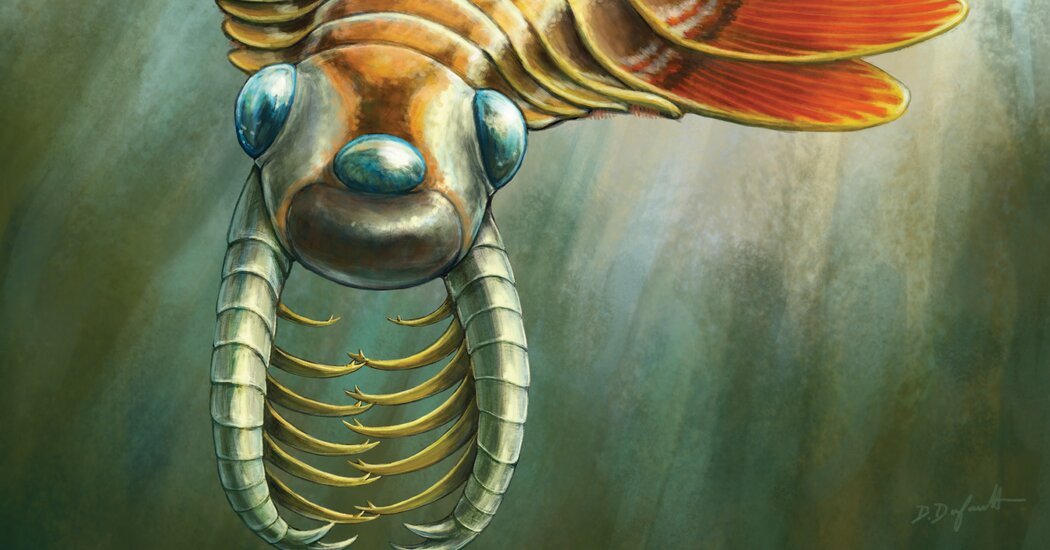Greater than 500 million years earlier than Matt Groening and the “Simpsons” launched us Blink, Mutated fish with further eyes, floating by way of the outdated fish gap of Springfield, a triak predator pursues prey by way of the seas of the Cambrian interval. After grabbing his profession, a pair of gripping nails of the backbone and a spherical mouth coated with tooth would end the work.
Generally known as Mosura Fentoni, this creature is a worthy addition to quirky Preserved within the bridges of Burgess, a big fossil deposit within the Canadian rocks. Nevertheless, the anatomy of the animal, described on Wednesday within the journal Royal Society Open ScienceIt reveals that Mosura will not be as alien because it appears.
The primary specimen of Mosura was found greater than a century in the past by Paleontologist Charles Wolcot, who found the Burgess shale in 1909. In current a long time, paleontologists on the Ontario Royal Museum in Toronto have found dozens of extra fossils of Mosura they’ve named Marine Mosa.
They weren’t fish, nevertheless it was clear that marine moths had been linked to a radio -duty, a bunch of arthropods of ancestors dominated by Cambrian meals chains. However the extra cautious inspection of the animal wouldn’t have occurred, till in 2012 the Marble Canyon didn’t discover three of the specimens of Mosura, overcoming the slate.
“The presence of this assortment of outdated and new specimens kicked us into gear to lastly perceive this animal,” says Joseph Moyyuk, a paleontologist who research the fossils of the Marble Canyon as a doctoral pupil.
Dr. Moysiuk partnered together with his advisor on the Museum of Royal Ontario, Jean-Bernard Caron, to look at about 60 copies of marine moths. Like different creatures of Burgess’s slate, many Mosura specimens had been effectively preserved, retaining traits akin to digestive tracts and circulatory techniques. Some even had traces of nerve bundles in every of the three eyes.
The group shoots Mosura’s specimens below polarized gentle to seize the detailed anatomy of flattened fossils.
The figuring out attribute of dwelling arthropods is the division of their our bodies into specialised elements. For instance, crustaceans as crabs have totally different appendages tailored to carry out sure capabilities akin to consuming or strolling. The fossils of many ancestors of early arthropods, together with different radioodonts, reveal comparatively easy plans for the physique. Due to this fact, researchers have lengthy recommended that segmentation takes a very long time to develop.
Mosura nails this pattern. Though it is just 2.5 inches lengthy, the physique of the creature is split into as many as 26 segments.
“That is one thing we’ve by no means seen on this group of animals,” says Dr. Moysiuk, who’s now within the Winitoba Museum in Winnipeg, “not solely when it comes to the massive variety of segments, but in addition in how they’re distinguished from different elements of the physique.”
Along with its vast swim valves, the animal had a extremely segmented trunk at the back of its gills. In response to researchers, this area resembles belly -like constructions that horseshoe crab, Woodlice and a few bugs use for respiration.
Optimization of oxygen consumption can be important to an energetic predator like Mosura. Researchers say the animal pursued a tiny prey by way of open water. Furthermore, he most likely needed to transfer away from the bigger contemporaries just like the two-meter Anomalocaris or Titanocori in the form of a spacecraftS
Since no different radio has possessed such a specialised trunk, the researchers put Mosura in their very own group. And as a substitute of naming the animal after This triak caricature fishThe group attracts inspiration from one other reference to the popular culture, Mothra, the wing Nemesis of Godzilla. In response to Dr. Moyyuk, the title is a nod to each the nickname of the creature and the lasting reputation of Burgess Shale Cretters in Japan.
The group watched different exceptional traits in Mosura, together with darkish, reflecting spots within the physique of the creature and swim valves. Researchers say they characterize Lacunae: inside cavities that maintain the animal’s blood after being pumped by their coronary heart.
Nevertheless, not all researchers are satisfied that these marks are fossilized blood luggage. In response to Joanna Wolfe, a paleontologist at Harvard College who has not participated within the new guide, they’ll characterize different traits akin to bowel glands.
Whereas a few of the traits of Mosura could also be ready for a scientific debate, Dr. Karen believes that the segments of the physique of this historic sea create its reference to dwelling arthropods. “It is actually a really unusual animal,” he mentioned, “however possibly not essentially as unusual because it seems to be.”

